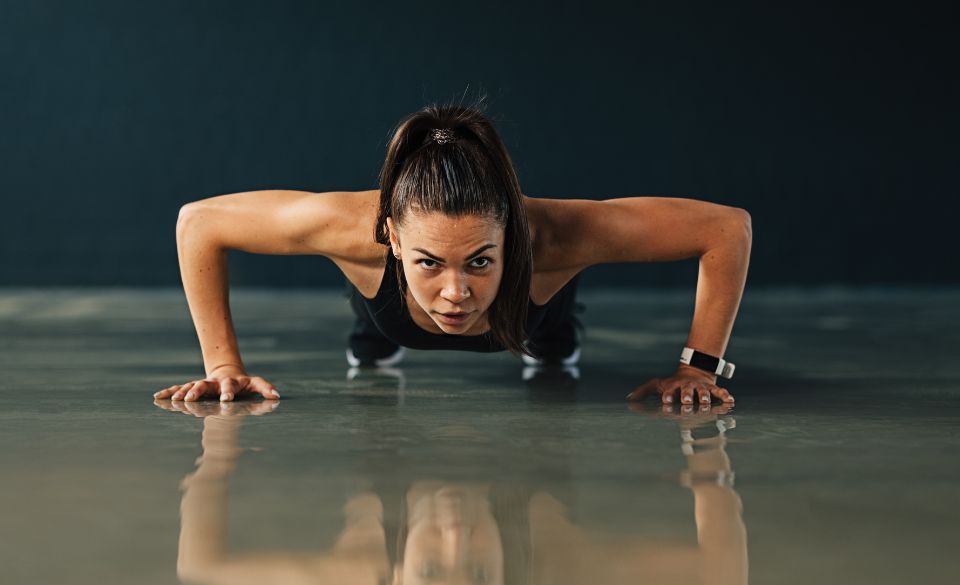
Arm Position For Push Ups – Everything You Should Know
Page Contents
How To perform A Push Up
Are you looking to improve your body strength, core stability and muscles? Learning to perform a proper push up is a great way to do it. Push ups are a fantastic upper body exercise that help to develop upper body strength and tone your arms, shoulders, chest, and abs.
Here is a step-by-step guide on how to do a push up:
1. Start in a plank pose. Position yourself on the ground with your hands slightly wider than shoulder-width apart, and your feet together. Your core should be engaged, and your body should form a straight line from your shoulders to your feet.
2. Lower yourself. Keep your body in a straight line as you slowly lower yourself down. Your chest should nearly touch the ground as you do this.
3. Push yourself up. Engage your core, chest and arm muscles and push yourself up until your elbows are straight again.
4. Repeat. Complete your desired amount of repetitions.
Some tips for proper push ups:
– Keep your body in a straight line from your shoulders to your feet.
– Make sure your elbows stay close to your body as you do the push up.
– Engage your core and keep your body tight throughout the exercise.
– Keep your head and neck in a neutral position throughout the exercise.
– Don’t lock out your elbows at the top of the push.
With practice and improved technique, you’ll soon be doing push ups like a pro! Push ups are a fantastic upper body exercise, so don’t forget to include them as part of your regular workout routine.
Arm Position For Push Ups
One of the most basic and beneficial upper-body exercises is the push-up. When done correctly, they effectively work the chest, triceps, shoulders, and core muscles, making them an essential exercise for strengthening these areas. While the traditional form of push-ups is fairly straightforward, there are some very important components to keep in mind for proper form, such as arm position.
The arm position for a traditional push-up is a wide elbow position. Elbows should be tucked in toward the body, not flared out or stiff. The arm position should be slightly below shoulder level, and the wrists should be aligned with the elbows at a ninety degree angle. The hands should be open and relaxed, with the palms of the hands pushing against the floor. This will help to ensure proper arm positioning for chin-ups and pull-ups.
In addition to traditional push-ups, there are other variations on this exercise. For example, handstand push-ups require the arms to be positioned much higher than traditional push-ups, and the hands should be slightly wider than shoulder-width apart. The elbows should remain tucked against the body and the wrists should be rotated slightly outward.
The core is also engaged during push-ups, so the back should remain in a neutral position throughout the exercise. The core muscles should be engaged and the spine in a neutral position, not rounded or arched. Keeping the core engaged and spine neutral is essential for proper form and preventing injury.
Overall, the arm position for push-ups is one of the most important aspects of correct form. It ensures proper engagement of the chest, shoulders, triceps, and core muscles, and helps to reduce the risk of injury. Keeping the elbows in, wrists rotates outward, different variations on the push-up, and maintaining proper back alignment helps to ensure that you perform the exercise correctly and get the most benefit out of each rep.
Different Variations Of The Push Up
The push up is a classic bodyweight exercise used to build upper body strength. It works your chest, shoulders, and triceps and can be adjusted for any fitness level. There are many variations of the basic push up that can be used to make the exercise more challenging or to target different muscle groups. Here is a look at a few of the most popular versions of the push up.
1. Standard Push Up – The classic push up begins in a plank position with hands placed slightly more than shoulder-width apart. Keeping your core tight, bend your elbows and lower your chest to the ground. Push back up to the starting position.
2. Wide-Grip Push Up – This variation is performed with the hands placed slightly wider than the standard push up. The wider grip targets the chest muscles more than the triceps.
3. Diamond Push Up – Also known as the triceps push up, this variation is performed with hands placed close together to form a diamond shape. This focuses the effort on the triceps and is an excellent option for those looking to build up their arm strength.
4. Plyo Push Up – Plyo push ups are a great way to add a bit of intensity to your push up routine. Start in a plank position, then lower your chest to the ground explosively and push back up to the starting position.
5. Single Leg Push Up – This push up variation works both your upper body and your core. Start in the standard push up position but raise one leg off the ground. Bend the elbows and lower the chest to the ground, then push back up to the starting position.
6. Decline Push Up – The decline push up is a more difficult version of the standard push up. Start in the standard push up position but have your feet elevated on a bench or chair. This variation requires more effort and works the chest muscles in a slightly different way.
These are some of the most popular variations of the traditional push up. Becoming familiar with each variation will help you to make the most out of each workout. Push-ups can be done anywhere and provide an easy way to strengthen your upper body, no matter your fitness level.
Should you straighten your arms when doing push-ups?
There are two main reasons why you should straighten your arms when doing push-ups. The first is that it enables you to work more muscle groups. When your arms remain bent, you’re primarily using your chest and shoulder muscles, but when you straighten your arms, you’re also engaging your triceps, biceps and core. This makes the exercise more effective and provides a greater range of motion.
The second benefit of straightening your arms is that it increases the stability and balance of the exercise. This helps you to balance your body weight more easily, and results in greater control during the exercise.
On the other hand, there are some potential downsides to straightening your arms. One is the risk of injury. As the arms are straightened, there’s an increased chance of strain and overextension. Additionally, you may find when you straighten your arms that your wrists remain bent, which can also lead to discomfort or injury in the long run.
The most important thing to consider when deciding whether to straighten your arms when doing push-ups is your level of strength and fitness. If you’re new to exercising or have weaker arms and wrists, you may find it difficult or uncomfortable to keep your arms straight. If this is the case, it’s best to start with bent arms and work up to straightening them as your strength and balance improves.
In conclusion, it’s important to understand the advantages and disadvantages of straightening your arms when performing push-ups. Doing so can help to engage more muscle groups, increase stability and balance and make the exercise more effective overall. However, if you’re not yet strong enough or have weaker wrists, it’s best to start with bent arms and work up to straighter arms as you progress.


